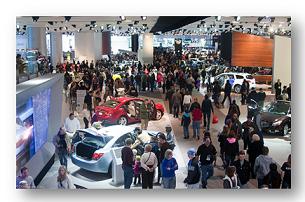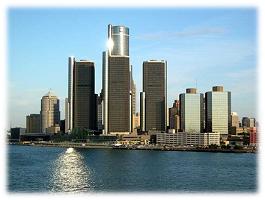Late last year, we ran a post that was essentially a promotional video for Cadillac’s new CUE system. Despite being deep into December, a time when blog traffic typically slows down, this post blew up, generating lots of page views and many passionate comments from radio people.
There is concern among many about radio’s place in the cars of the future. The paradigm is shifting and the days when broadcast radio stations dominated the dashboard environment (the good old days: 12 FMs, 6 AMs, and a CD player) are rapidly coming to an end.
 Satellite radio may have been a catalyst, and while it has failed to live up to its hype, its place in cars (including rentals) was the beginning of the disruptiveness. But today’s sophisticated in-car “desktops” open up an entirely new arrays of options to consumers, while creating challenges to traditional broadcast radio operators. There’s a buzz about cars in this country – again – and we are beginning to feel that every year in Detroit for the North American International Auto Show (pictured) which gets going in just a week or so.
Satellite radio may have been a catalyst, and while it has failed to live up to its hype, its place in cars (including rentals) was the beginning of the disruptiveness. But today’s sophisticated in-car “desktops” open up an entirely new arrays of options to consumers, while creating challenges to traditional broadcast radio operators. There’s a buzz about cars in this country – again – and we are beginning to feel that every year in Detroit for the North American International Auto Show (pictured) which gets going in just a week or so.
We’re off to CES next week, and we’ll be reporting back to you about coming innovations that are just around the corner. But in the meantime, radio’s in-car challenge isn’t going to be solved by hoping that the National Transportation Safety Board simply bans the use of cell phones in cars. Like the effort to legislate FM tuners in cell phones, radio would be smart to develop its own viable mobile strategies, rather than hope that Congress will throw the industry a bone.
And that’s why radio needs to be proactive here – not just to protect its in-car listening foundation but to also make its case to automakers and auto dealers about why broadcast radio is an important medium – when it comes to consumer tastes as well as an effective advertising vehicle. Last time I checked, radio’s top billing category was still…cars.
So why then doesn’t the industry take the offensive here? And it starts with face-to-face selling – telling radio’s historic and positive story about its role in cars.
Perhaps it starts with “The Radio Show.” Paul has long opined that markets like Austin and Charlotte are lovely, but are not important markets where radio can show off its glitz, glamour, and value – especially to advertisers. He contends that while more expensive, the NAB/RAB ought to be focused on markets like New York, Chicago, and L.A. – advertising centers where the industry could actually put on a “radio show.”
 The 2011 “Radio Show” in Chicago was one of the best in recent memory, but truth be told, the industry wasn’t really focused on presenting RADIO as a great medium – it was more interested in simply putting on a show for its membership. That’s a missed opportunity because “The Radio Show” tends to lack celebrity, rarely featuring the biggest on-air stars who make radio a great business. Instead, panels and the convention floor are littered with industry types and engineering and electronics products.
The 2011 “Radio Show” in Chicago was one of the best in recent memory, but truth be told, the industry wasn’t really focused on presenting RADIO as a great medium – it was more interested in simply putting on a show for its membership. That’s a missed opportunity because “The Radio Show” tends to lack celebrity, rarely featuring the biggest on-air stars who make radio a great business. Instead, panels and the convention floor are littered with industry types and engineering and electronics products.
Radio’s smartest move for 2013 (this year’s show is set for Dallas) would be to locate the show in my hometown, Detroit. Now I know there are downsides here, especially when it comes to industry attendance. But on the upside, the Chicago show proved that the Midwest works, attracting convention-goers from all over the U.S.
Broadcast radio needs to deliver a message to the automakers: the medium is healthy, vital, and in-touch with today’s consumers. And it needs to emphasize its value to these car companies, dealers, and dealership groups as important local advertising vehicles that deliver showroom traffic and sales. I bet that every Detroit radio station would step up big time with promotions, tie-ins, and on-site events that would only enhance “The Radio Show” and its efforts to reconnect the industry with the changing automotive world.
So when Gordon Smith gets in front of the crowd at the Anatole in Dallas this September and announces the 2013 location for “The Radio Show,” I’m hoping that for the sake of the industry the NAB and RAB represent, they take a more strategic approach to the selection city.
Why not Detroit?
 P.S. By the way, while searching for images for this post, I ran across this Mensa poster. Those brainiacs chose Detroit for their 2010 convention and I thought you’d appreciate their “smart” sense of humor about the event (that was actually headquartered in suburban Dearborn, home of the Ford Motor Company.)
P.S. By the way, while searching for images for this post, I ran across this Mensa poster. Those brainiacs chose Detroit for their 2010 convention and I thought you’d appreciate their “smart” sense of humor about the event (that was actually headquartered in suburban Dearborn, home of the Ford Motor Company.)
I checked in with Catherine Barney, American Mensa’s Marketing & Communication Director. Here’s what she told me about their journey to Detroit:
“We had a great convention in 2010. The ad was actually the work of the Detroit Convention Visitors Bureau and we were happy to be associated with it. It showed up in so many publications, and caught the attention of media around the country.
We hosted 1,925 Mensa members in Dearborn – a great turnout! Attendees came from 46 states and 13 countries. They had ample opportunity to explore the area, as we had held seven different tours. Mensans had the chance to explore Frankenmuth, Lake Erie wineries, the architecture of Detroit and even take in a Tigers game. It was a great location for us, too, as it allowed us to hold our convention in conjunction with Mensa Canada.
Overall, it was a wonderful event and we were overwhelmed by Detroit’s hospitality.”
- Simply Unpredictable - April 10, 2025
- Flush ‘Em Or Fix ‘Em?What Should Radio Do About Its Aging Brands? - April 9, 2025
- Radio: It’s Time To Stop Playing Small Ball - April 8, 2025




I thought your post on the Cadillac CUE system was spot on, and made a couple of comments on it as well. I think you have great idea, taking the Radio Show to Detroit. Show the automakers and consumer electronics industries that free, over the air radio is still a force to be reckoned with.
Sadly, I fear that the people who run the big radio companies will continue to let the industry implode and by the time the Fall of 2013 rolls around, our beloved industry will look like the worst blighted neighborhoods in the Motor City. Broadcasters seem unable to think long term, and that lack of vision will destroy any credibility and power our industry has.
I made the offer to help in any way I can in a comment on your CUE piece, and I remain ready, willing, and able to do whatever I can to promote radio as an entertainment and advertising powerhouse. The NAB isn’t doing it, the RAB isn’t doing it (although perhaps Erica Farber can help that), and the big radio companies certainly aren’t doing it. Its time for some kind of industry group of people who love and believe in free, over the air radio to be formed so that the medium can be promoted correctly to decision makers and consumers.
Who’s in?
I appreciate your frustration. There are a lot of moving parts – technology, the economy, and of course, change. Part of it is looking for those radio/media folks with vision – and they are out there. The trade organizations have their challenges, too. I am hoping that if we continue to push important agendas, change will occur. I think back to the “Goin’ Mobile” study in ’10. A goal was to get mobile on the agenda of every broadcast company out there – and I think by and large, that’s happened. No one bargained for all this change, especially those who have been the business for decades. Change is hard, but incrementally, there’s been progress. Hang in there and thanks for contributing to our blog – it is appreciated.
Yes, there has been progress. But some of the biggest companies with the most stations have been the slowest to adapt to the new world and are far behind people like Kelly Urich at kcradio.com who runs a first class radio station on the internet from his basement. He’s got a mobile app and everything. Yet I still can’t get the CBS radio.com Android app to work on my phone or Kindle.
That’s kind of a microcosm of what’s wrong with this picture. There are innovators out there, but at least 2 of the biggest companies aren’t looking very far past the next monthly number or quarterly earnings call, and that lack of vision will continue to make broadcast radio irrelevant to listeners, consumer electronics makers, and advertisers. It can take years for an idea to come off a designer’s desk and into the dashboard of a car, and if our industry continues to ignore all of the people thinking about 2015 now in favor of a handful of analysts, we’ll be left in the dust.